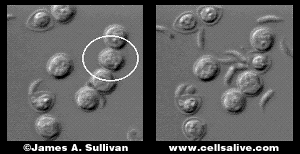Protozoan Parasites
 Connections
Connections 
- Take the Microbes Quiz
Giardia lamblia
Signs posted in wilderness areas often warn about Giardia in streams. Commonly found in wild animals such as the beaver, this graceful, flagellated organism may infect unwary hikers. But giardiasis can also be contracted via contaminated foods. It is identifiable microscopically by the appearance of two "eyes" that are actually a pair of nuclei, seen in the phase contrast image. Giardia uses a ventral suction cup to attach to its host's intestinal epithelium. There is some evidence that a heavy infection of attached Giardia physically blocks the important transport of nutrients across the epithelium.
Entamoeba histolytica
This water-borne pathogen, can cause diarrhea or a more serious invasive liver abscess. When in contact with human cells, these amebae are cytotoxic. There is a rapid influx of calcium into the contacted cell, it quickly stops all membrane movement save for some surface blebbing. Internal organization is disrupted, organelles lyse, and the cell dies. The ameba may eat the dead cell or just absorb nutrients released from the cell.

Cryptosporidium parvum
The cysts of Cryptosporidium are of increasing importance because of their presence in water supplies. Passage through the stomach, or in this case chlorine bleach, weakens the wall of a cyst (left, circled). When in the gut, four spindle-shaped motile sporozooites burst from the cyst to infect gut epithelial cells and continue their life cycle.
